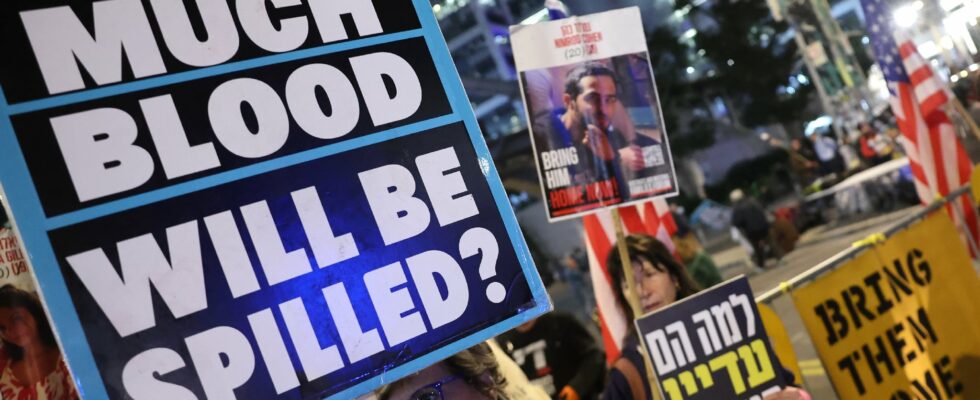The negotiators meeting in Doha to reach a ceasefire in Gaza are seeking this Wednesday, January 15 to finalize an agreement, now “at the final stage” according to Qatar, after 15 months of a war between Israel and Hamas which caused tens of thousands of deaths in the Palestinian territory.
While the two parties are still making their demands, American President Joe Biden and Egyptian President Abdel Fattah al-Sissi urged them, during a call on Tuesday, “to show the necessary flexibility”, according to the Egyptian presidency. The “main problems” have been resolved according to Qatar, which however did not specify which ones. “We hope that this will lead to an agreement very soon,” a spokesperson for Qatari diplomacy said on Tuesday. Islamic Jihad, an armed group allied with Hamas, announced Wednesday that it was participating in the discussions. Here is what we know about the ongoing talks, which are taking place with Hamas and Israeli negotiators present in two separate rooms.
A hostage/prisoner exchange
Israeli government spokesman David Mencer confirmed in an online press briefing that Israel was seeking the release of “33 hostages” during the first stage of the truce. He added that Israel was prepared to release hundreds of Palestinian prisoners in exchange. “Israel is prepared to pay a high price, hundreds,” he said, referring to the number of Palestinian prisoners.
An Israeli official who requested anonymity earlier said that “several hundred terrorists” would be released in exchange for the hostages, although their final number will depend on how many people are still alive among the 33 hostages on the initial list. releasable.
According to two sources close to Hamas, Israel is expected to release around 1,000 Palestinian prisoners, including those sentenced to “long sentences.”
The 33 hostages are among 94 captives still held in Gaza since October 7, among whom 34 were declared dead by the Israeli army. One of the two sources close to Hamas specified that these 33 Israeli hostages would be released “in groups, starting with children and women.” According to the Times of IsraelIsraeli officials believe they are all alive, but Hamas has not yet confirmed.
Last week, Hamas said it had agreed to release 34 hostages in the first stage of an agreement. But Israeli forces recovered the body of one of the people on the list, reducing the total to 33.
Israeli buffer zone
According to an Israeli official, negotiations for the second phase of the agreement will begin on the “16th day” after the entry into force of the first phase of the agreement. The second phase will concern the release of the last hostages, “i.e. the soldiers, the men old enough to be mobilized and the bodies of the dead hostages”, according to the Times of Israel.
Israeli media reported that under the pending deal, Israel would maintain a buffer zone in Gaza during the first phase. Israeli forces should remain present up to “800 meters deep in the Gaza Strip, in an area stretching from Rafah in the south to Beit Hanoun in the north,” according to the source close to Hamas.
Israel will “not leave Gaza until all the hostages have returned, the living and the dead,” said the Israeli official. According to the daily HaaretzIsrael will allow the movement of Gazans from the south to the north of the Palestinian territory.
The source close to Hamas explained that Israeli forces would withdraw from the Netzarim corridor – south of Gaza City, which cuts the Palestinian territory into two parts – but would remain deployed on the Salaheddine road, the main axis linking the south. in the north of the territory. An electronic checkpoint equipped with cameras will be installed on the Netzarim corridor, where “no Israeli forces will be present”, according to this source.
International pressure
Since the start of the war, only a one-week truce has been observed at the end of November 2023, the negotiations carried out since coming up against the intransigence of the belligerents. Previous discussions stumbled over several issues: the duration of a ceasefire, the extent of humanitarian aid authorized to enter Gaza, the logistics of returning displaced Palestinians, the withdrawal of Israeli troops and governance of Gaza after the war. It is unclear whether compromises have been reached over these disagreements. Israeli Prime Minister Benjamin Netanyahu is firmly opposed to a total withdrawal of troops from Gaza and has rejected any Palestinian governance in this territory.
International pressure has increased for a ceasefire associated with the release of the 94 hostages still held in Gaza, 34 of whom have died according to the Israeli army. Especially after Donald Trump promised “hell” to the region if the hostages were not released before his return to power. “Time is running out, the living hostages will eventually die. The dead hostages risk being lost. We must act now,” said Gil Dickman, cousin of hostage Carmel Gat, during a rally Tuesday evening in Jerusalem.
This Wednesday, Palestinian Prime Minister Mohammed Mustafa said that the international community should maintain pressure on Israel so that it accepts the creation of a Palestinian state after a truce. “The ceasefire we are talking about […] is mainly due to international pressure. This shows that pressure is paying off,” he said before a meeting in Oslo devoted to the two-state solution, Israeli and Palestinian, in the Middle East. Norwegian Foreign Minister Espen Barth Eide, host of the meeting, for his part argued that “a ceasefire is a precondition for peace, but it is not peace”. “We must now move towards a two-state solution. And since one of the two states already exists, namely Israel, we must build the other state, which is Palestine,” he added. Analysts say the two-state solution is a more distant goal than ever, the Israeli Prime Minister, Benjamin Netanyahu, firmly supported by President-elect Donald Trump, being opposed to the establishment of a Palestinian state.
